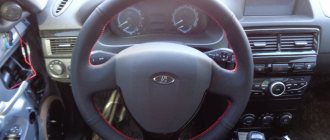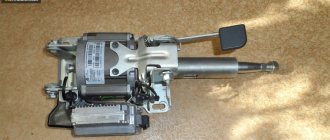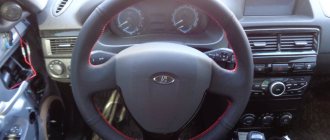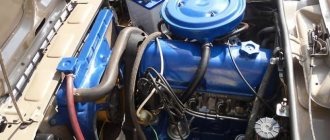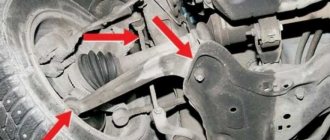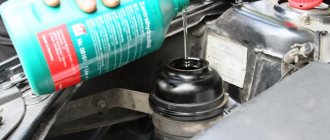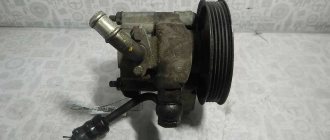Motorists know how much nerves are wasted when problems with power steering occur. The steering wheel behaves strangely and turns much more difficult at idle or low speeds. A whistling sound is heard from the pump bearing. Leakage of working fluid onto the engine or onto the road at the location of the unit. The rotation of the steering shaft is accompanied by extraneous sounds.
These inconveniences can affect not only the driver’s nervous health, but also driving safety. What to do if symptoms of a pump malfunction appear? How to replace this power steering part? Is it possible and how to carry out repair work yourself? We'll tell you more about everything below.
Symptoms of power steering pump malfunctions
Although the vane and vane pumps installed in the power steering design do not break down so often, we will still consider what the signs are and how to extend the service life of the pump.
You can extend the service life by the following actions:
- Change the fluid on time. Few people change the oil in their hydraulic booster, but it becomes old and loses its properties. Therefore, it is necessary to do this.
- Monitor the fluid level in the power steering reservoir.
- Try not to turn the steering wheel when the internal combustion engine is not running. If the fluid in the power steering system does not move, the pump overheats. The oil does not move if you turn it many times with the engine off.
- When changing the oil, make sure that no debris gets in.
If you follow the operating rules, the power steering will last a long time. Check the oil level periodically. When adding fluid, add only the same brand.
If you notice signs of problems with the power steering system, you should not drive fast or long distances until the causes are eliminated.
Signs of problems with power steering:
- If you have difficulty turning the steering wheel at idle and at low speeds. At high speeds there are no problems with turning the steering wheel.
- If you find a fluid leak from the power steering system.
- If you hear extraneous sounds while turning the steering wheel.
- If you hear a whistling or humming noise from the bearing. If the bearing is removed, there will be play when the pulley rolls.
Maintenance and care of the power steering system
Since the condition of the steering system affects driving safety, special attention must be paid to its maintenance and timely detection of problems.
The list of actions aimed at servicing power steering should include, first of all, the following:
- monitoring the condition of the oil;
- monitoring the condition of the protective elements (anthers) of the rack;
- maintenance of high and low pressure hoses.
It is also important to monitor the occurrence of leaks of working fluid at the assemblies and connections of power steering parts. If they are missing, you should pay attention to the sound that the units make.
Power steering: what is it and what does it consist of?
Hydraulic power steering is a part of the steering mechanism that makes it easier to control the car when turning or hitting uneven roads. The hydraulic booster reduces the effort the driver puts on the steering wheel while driving. If you have a working hydraulic booster, it is much more comfortable for the driver to drive, there is less strain on his hands, and the parking process is easier.
We recommend: Do-it-yourself repair of the starter retractor relay
Power steering components:
- Pump . The main part of the system. The belt connecting the booster to the crankshaft drives the pump, so the whole mechanism works when turning;
- Distributor . A high-pressure pump supplies oil to a distributor that is sensitive to the level and degree of contamination of the oil. If the tie rods are on the sides of the rack, then the piston is in the center of the body. There may be a different type of distributor. When the piston is on the side and the rods are in the center of the rack;
- Steering gear;
- Steering bipod . It's also a connecting rod. The main part of the mechanism, which performs the function of transmitting force from the sector shaft to the longitudinal thrust;
- Connecting hoses . They are responsible for the circulation of fluid throughout the entire mechanism. Connect the reservoir with hydraulic fluid to the pump, distributor and hydraulic cylinder;
- Hydraulic oil reservoir . From the oil tank it enters all components of the mechanism, lubricating all parts, and then returns to the reservoir.
Power steering
So, the introduction of artificial intelligence in transport management is an incredible leap into the future, but it is still not cloudless.
Another scenario for the development of events is the creation of a car that will be driven by a person, and all his actions will be relaxed, intuitive and confident. For this purpose, engineers have come up with special mechanisms that have been used for a long time, but continue to be improved.
The two most common types of power steering are electric and hydraulic. In our article we will take a detailed look at power steering faults and how to fix them.
Tips for using power steering
Recommendations that will increase the service life of the power steering system:
- You should always monitor the level of lubricant in the tank; if there is a shortage, fluid is added. It is important to replace the substance in a timely manner and monitor its condition. When purchasing new oil, you need to check its quality for color and smell.
- The steering wheel should not be held in the extreme left or right positions for a long time, more than five seconds. This leads to excessive load on the pump mechanism, which operates without cooling.
- When the car is parked, you must ensure that the wheels are in a straight position. This will reduce the load on the power steering system during further startup of the power unit. It is especially important to monitor this in the cold season, when the lubricant thickens quickly.
- You cannot delay repairing the system. If signs of a malfunction appear, you need to perform diagnostics and look for the cause of the problem. Operating a car with a non-functioning or defective power steering is allowed, but highly undesirable. Timely repairs will eliminate the problem at lower financial costs.
- It is always necessary to monitor the condition of the steering rack, in particular, the anthers and seals. This will increase their service life and save money on further repairs.
- Long-term use of a vehicle with a damaged pumping device is not allowed. This will cause accelerated wear and breakdown of the distribution mechanism, as well as the constituent elements of the steering system.
- You should always monitor the tightness of the power steering. If there are leaks, a complete diagnosis of all joints and seals is performed. Problems must be resolved in a timely manner.
- Periodically it is necessary to diagnose the tension of the drive belt. If necessary, it is adjusted.
- Once every 1-2 years you need to change the filter located in the expansion tank.
We recommend: How to fix a gas tank breakdown yourself - repairs on the road. Cold welding gas tank repair
Increase steering wheel power
Malfunctions of the power steering, which are manifested by an increase in force on the steering wheel, indicate a clogged system. In this case, you will need to check the filter element of the power steering reservoir. If it is noticeably clogged, the tank needs to be replaced.
Then flush the system by replacing the working fluid twice and then pumping the system. This operation should also be carried out when turbidity of the liquid is detected.
Types of faults and their symptoms
The manifestations of pump breakdowns described above may in reality not be related to the pump itself. Therefore, first you need to carefully inspect the entire power steering system. And only if the problem is not found, start working with the pump itself.
Malfunctions are divided into two types:
- mechanical damage and wear. These include the appearance of burrs, problems with the bearing, irregularities in the internal part, wear of the gasket, etc.;
- problems with hydraulics. Associated with insufficient fluid levels, incorrect fluid selection and “aging”. The entry of debris into the system can also lead to the appearance of “symptoms”, and, in the future, to breakdown. Banal airing refers to the same type of malfunction.
The first can only be determined by disassembling the power steering pump and inspecting each of its components. As for the second type of malfunction, first of all you need to answer the questions - how much time has passed since the fluid in the system was changed? Is the liquid selected according to the instructions? Is its level sufficient? And in case of airing, it is often enough to pump the hydraulics to restore power steering functionality.
In any case, manufacturers recommend that if any problems arise with the pump, do a complete overhaul and cleaning. This will help reduce the likelihood of wear and tear, and therefore increase the life of the entire system.
labavto.com
In many cars, power steering is the main component of the steering system. Of course, like any other component, the hydraulic booster tends to break. In this article we will talk about the main symptoms of malfunctions. You will also learn how to repair power steering yourself and how to operate it correctly.
How to repair a power steering pump with your own hands
Before you start disassembling the device, you need to check whether there is an air lock in the system that is interfering with the movement of fluid. It is because of the airlock that problems most often occur in hydraulic systems. That is, first of all we pump the power steering. If after this the reasons do not disappear, then we proceed to dismantling the hydraulic unit, disassembling it and repairing system parts.
Repair sequence:
- We do a complete cleaning of dirt. At the same time, make sure that dirt does not get into the hoses.
- Remove the drive belt.
- Drain the oil as much as possible.
- Now you need to put a mark on the power steering shaft relative to the elastic coupling (to do this you will have to crawl under the car). Using a hexagon, unscrew the steering shaft.
- We dismantle the steering rods. To do this, you need to lift the left side of the car with a jack and remove the wheel. Usually, to remove the rods, you need to use a special puller. But, in this case, this can be done without a puller.
- Take a 15mm socket wrench and loosen the bolts securing the power steering to the side member. This is done from the side of the wing arch. We unscrew 2 bolts completely, leaving one in place.
- Now, what remains in the hoses needs to be drained. To do this, substitute a cut empty canister or other container.
- When the liquid has flowed out of the hose, you need to plug them with rags.
- Now you need to unscrew the remaining one bolt. We unscrew it with one hand and hold the hydracha device with the other.
- Carefully and slowly remove the pump.
We recommend: Kubota is a masterpiece of design thought.
Once the pump is removed, we begin to disassemble it.
First, we inspect whether the body is broken or whether there is metal corrosion. During disassembly, the cause of the breakdown is usually found out. Next, we disassemble the pump into its components.
How to disassemble the power steering pump:
- The retaining ring holds the bearing. This ring must be removed using a puller.
- Unscrew the bolts securing the rear cover. Remove the cover using a slotted screwdriver. You must remove it carefully so that the blades and the pump housing do not fly out.
- Those who do not remember the location the first time are advised to take blank A4 sheets, number them and lay them out. During the disassembly process, the parts are laid out on these sheets in a certain order. You also need to remember that the rounded part of the blades must then be installed outward.
- Now you need to remove the plate and the parts underneath it.
- After this, we proceed to removing the shaft. It must be carefully knocked out; for this you can use a brass hammer or a rubber one, which is used by tilers.
- The bearing must be pressed out from the removed shaft.
- If the problem was in the bearings, that is, it may be jammed, or crumbled, or simply rotates tightly, then we press in a new bearing.
- In addition to the bearing, it is necessary to check all parts of the device and, if necessary, replace them.
- At this stage, when the failed parts have been replaced, it is necessary to assemble the power steering device.
Self-repair of hydraulic booster
Troubleshooting problems with damaged hoses or drive belt tension is quite simple. Check the system for defects and, if necessary, replace worn parts or tighten the belt. The problem with a low fluid level in the expansion tank can also be easily solved. However, in other cases, problems are not resolved so quickly.
Air in the system . Air bubbles can be removed using special equipment, which is rarely used by ordinary drivers. As a rule, in this case it is advisable to use the services of service centers or auto repair shops. Bleeding the system under high pressure will remove air from it.
Minor fluid leak . If there is a slight oil leak in the power steering system, and there is no way to troubleshoot the problem, you can solve the problem with the help of special additives. The unique composition will eliminate small leaks by restoring the elastic properties of worn gaskets.
Pump failure . You can repair the pump yourself if you have sufficient experience, basic knowledge of the design and the appropriate tools. If you are not confident in your abilities, then most likely you will just have to buy and install a new pump.
As a rule, the main malfunctions of the pump are easily eliminated, even without knowledge of its design features. The complexity of this event lies not so much in the repair itself, but in the competent dismantling of the worn-out unit, subsequent disassembly of the pump and its correct installation after repair. As you know, the main working element of a power steering pump is the blades. Basically, they fail or work with insufficient performance when a large amount of dirt accumulates or any defects appear.
In most cases, to eliminate the malfunction, it is enough to disassemble the pump and correct defects (deterioration of surfaces) with regular sandpaper. Contaminants are removed by flushing the system.
Source of the article: https://vipwash.ru/rul/remont-gidrousilitelya-rulya
Useful recommendations.
So, we have successfully studied various signs of power steering problems and the most common breakdowns of this mechanism. In conclusion, we will give a few recommendations that will help preserve the performance of this mechanism for a very long time:
— change the power steering fluid in a timely manner, because a dirty mixture contributes to rapid wear of various components of the specified unit (seals, rubber bushings and power steering pump).
— You need to carefully monitor the power steering fluid level. When it drops below the permissible level, then the power steering components begin to wear out very quickly, which provokes early repairs.
- fill only with the mixture that is created specifically for your car, and not for any other. At the same time, read in detail the recommendations of the car manufacturer itself.
Leakage of working fluid
Very often, power steering malfunctions come down to leakage of working fluid. It can leak in places where pipelines are attached or in case of damage to these pipelines.
In the first case, it is recommended to replace the clamps on the pipelines. If the pipeline is damaged, it must be replaced, which will require draining the working fluid from the system. Moreover, it is advisable to change all pipelines at once. After replacing the pipelines, new fluid is poured into the system and pumping is carried out.
It is important to remember that reusing power steering fluid is not recommended, as this can lead to failure of power steering components.
Power steering KamAZ 4310 device and adjustment
To understand how the amplifier functions, let's look at a schematic representation of the mechanism's operation. The figure shows that the movement of the KamAZ - 4310 vehicle in a straight position forces the auger (15) and the device that reorients the flow (20) to adhere to the middle. This position forms a single connection of elements: supply and discharge channels (26, 32, respectively), voids (7) and (25) of the hydraulic chamber. At the same time, the lubricant circulates freely, making its way from the pump through the control valve (19) and again enters the reservoir of the hydraulic circuit (31).
Turning the steering wheel (1), see diagram, provokes rotation of the screw (15). Removing the wheels (12) from the equilibrium position causes resistance from the rack piston (8), which controlled the linear movement. The resulting force tends to move the auger along the axis in the direction of rotation; this is prevented by the centering spring elements (23). The force exceeding the spring force moves the auger, moving the flow reorientation device behind it. The consequence of the actions taken is that the chamber void communicating with the discharge channel is disconnected from the drain channel and vice versa. The liquid pumped into the void of the channel by the pump acts on the rack valve (8), forming a pressure on the sectoral mechanism (6) of the bipod. It becomes easier to turn the wheels.
Amplifier bipod KamAZ-4310:
The pressure in the voids of the power steering KamAZ 4310 3400020 03 is stabilized, leveling out to the level of resistance to wheel rotation. At the same time, the compression of the cavity of the reactive displacers (22) increases. The resistance increases in tandem with the pressure in the working chamber; accordingly, the force of the spool valve to return to the middle position increases, transmitting information to the steering wheel. Interaction helps the user to better understand and feel the road.
Fixing the steering wheel in an inverted position, without further turning, in accordance with the work of the spring elements and the pressure in the voids, moves the spool valve to an equilibrium position, but does not complete it. A gap that allows lubricant to pass into the return channel maintains the position of the wheels.
Making a direct movement and hitting a stone, the bipod shaft turns, moving the rack and pinion valve of the hydraulic booster (Article: 4310-3400020-01). Since the user is holding the steering wheel, the auger does not rotate and cannot move along the axis with the spool valve. The action will connect the void of the chamber with the pump discharge channel and break the connection with the return channel. The channel pressure will increase and balance the impact.
KamAZ 4310 power steering diagram:
Site subtitle
Troubleshooting if they appear on PPT power steering systems
Power steering
designed to carry heavy loads. It is designed in such a way that no obstacles arise during perfect maintenance and normal operation. If such appear, then the following recommendations will help detect and eliminate them. Before we start looking for some obstacles, we need to check the oil level in the reservoir with the engine running. The procedure for accurately filling with oil is described in detail in the corresponding section. However, we draw your attention to the fact that when using foam-type oils, obstacles may arise, because such oils have difficulty or do not eliminate air that is once in the power steering.
The steering wheel is difficult to turn when turning to the left
- Insufficient oil in the power steering. Open the oil reservoir and monitor the oil level. With the engine running, add oil to the upper mark on the oil gauge and remove air from the power steering by turning the steering wheel. Check the power steering for leaks and repair any damage.
- Air has entered the power steering. Check the tightness of the suction hose and the sealing ring on the pump shaft. Remove air from the power steering and add oil.
- The control valve in the pump is stuck or clogged. Remove the control valve, wash it and clean it from dirt. Also clean the suction hose and suction connection.
- The filter is broken (or the hole in the suction hose is clogged). Replace the filter, clean the lines.
- To make it in two parts, the cross-shaped joint is difficult to move. Turn the hinge repeatedly left and right to obtain a smooth motion so that it can move under its own weight. Otherwise, install a new hinge. Internal sealing parts are damaged. Send the hydraulic booster to one of the authorized service stations for repair.
The steering wheel is difficult to turn only when turning to the right
- The control limit valve is activated early (only on power steering with hydraulic control limit). Re-adjust the control limiters.
- Internal O-rings are damaged. Send the power steering to one of the authorized service workshops for repair.
- The distribution chute is not adjusted correctly (in this case, the power steering turns to its extreme position when you release the steering wheel from your hands). Adjustment - by the distribution chute manufacturer.
The steering mechanism turns hard when turning the steering wheel quickly
- Pump control valve clogged. Remove, rinse and clean the adjusting screw.
- The pump does not supply enough oil (wear on the rotors). Send the pump to an authorized service station, namely the factory, for repairs.
- Presence of air in oil. Remove air from the device and add oil if possible. Check the pump shaft for leaks.
The steering wheel is delayed in reverse
- The axle sleeves or transmission parts are not lubricated with grease. Lubricate the axle sleeves, joint knuckles and other parts of the transmission mechanism.
- The point of greatest engagement is too tight (applies to power steering with balls only).
 Re-adjust the point of greatest engagement. 1) Lift the front axle up and remove the bipod. 2) Set the power steering to the middle position (obtained by dividing the total number of revolutions by half). 3) Loosen the locknut. 4) Unscrew the control valve until the pressure on the adjusted point stops. 5) Turn the adjusting valve clockwise again until you feel slight resistance on the steering wheel. Therefore, constantly turn the steering wheel left and right by 1/2 turn. 6) Retighten the locknut and secure the valve. 7) To be sure, turn the steering wheel again completely in both directions, and at the same time watch for the appearance of a slow increase in the resistance to turning in the middle position. Reinstall the bipod and remove the front axle from the holders.
Re-adjust the point of greatest engagement. 1) Lift the front axle up and remove the bipod. 2) Set the power steering to the middle position (obtained by dividing the total number of revolutions by half). 3) Loosen the locknut. 4) Unscrew the control valve until the pressure on the adjusted point stops. 5) Turn the adjusting valve clockwise again until you feel slight resistance on the steering wheel. Therefore, constantly turn the steering wheel left and right by 1/2 turn. 6) Retighten the locknut and secure the valve. 7) To be sure, turn the steering wheel again completely in both directions, and at the same time watch for the appearance of a slow increase in the resistance to turning in the middle position. Reinstall the bipod and remove the front axle from the holders.
The car cannot be controlled perfectly when driving in a straight line.
- There is a small amount of oil in the hydraulic booster (air gets in). Add oil and remove air from the device with the engine running.
- Despite the sufficient amount of oil in the reservoir, air enters the power steering. Remove air from the power steering while the engine is running and add oil. Check the power steering for air leaks. Eliminate the causes of air ingress.
- The bolts securing the power steering column and spring brackets have been loosened. Tighten all fasteners. At the same time, pay attention to the absence of deflection in the power steering.
- The joints with the bipod knuckles have a gap. Install new joints with knuckles.
- Gap in the power steering valve with balls. Remove the power steering and repair it.
When driving, shocks are felt on the steering wheel
- There is not enough oil in the power steering. Add oil. At the same time, remove air from the power steering with the engine running.
- Despite the sufficient amount of oil, air penetrates into the power steering. Remove air from the power steering with the engine running. Check the power steering for air leaks. Eliminate the reasons for the penetration.
- Due to severe overload or improper maintenance, there is a gap in the steering mechanism (shaft - nut), i.e. in the ball channel. Send the power steering to an authorized service station for repair.
- The power steering segment shaft engagement does not engage the piston (only applies to power steering with balls). Adjust the center of force.
Rotating vibrations on the steering wheel
- Imbalance of wheels, i.e. drums. Balance statically and dynamically.
- Directionality, overhang and inclination of the front wheels. Re-adjust according to factory manual.
- Presence of air in oil. Remove air from the power steering and top up the oil if possible. Also check the pump shaft o-rings for leaks.
A big bump appears on the steering wheel
- Malfunctions outside the power steering: the power steering brackets are loose, i.e. the springs, the gap on the linkage joints. Tighten the power steering bracket and spring brackets. Replace the hinges with knuckles with new ones.
- Gap in the bipod rod. Replace the rod.
- Due to severe overload or improper maintenance, a gap has appeared on the power steering (shaft - nut), i.e. in the channel for the balls. Send the power steering to an authorized service station for repair.
- The engagement of the segmented axis of the power steering does not engage the piston without clearance. Adjust the center of pressure.
The power steering automatically rotates to the end position
Setting the valves to the hydraulic middle position is faulty. Re-adjust from the manufacturer.
Strong noise when the pump is running
- Attention. There is not enough oil in the power steering. Check the reason for the lack of sufficient oil. Fill the oil with the engine running up to the upper mark on the gauge and remove air from the power steering with the engine running.
- Air in oil. Check the tightness of the suction hose and the sealing ring on the pump shaft. If possible, replace the rings and remove air. Attention. Shaft sealing ring with double tongue. Lubricate the gap between the sealing tongues with hot bearing grease. Install the sealing tongues to the inside.
- Injection hoses are in contact with the frame or chassis (loud noise due to direct contact with metal). Ensure sufficient distance between vehicle parts and pressure hoses. If possible, install the hoses in rubber holders.
Loss of hydraulic oil occurs
- The oil reservoir cap is loose. Attach the cover.
- The sealing ring on the pump axis, i.e. the shaft, provides poor sealing. Install a new O-ring. Install the double tongue ring and lubricate the gap between the tongues with grease.
- The O-ring on the bipod provides a poor seal. Replace the ring, use tools 13 and 15, sometimes it is enough to remove dirt from the sealing tongue.
- The O-ring on the lower power steering shaft provides a poor seal. Replace the ring, check the working surface of the sealing ring on the shaft. Tighten the cover screws to the required tightening torque.
- O-rings on the intermediate shaft and section cover provide poor sealing. Replace O-rings. Tighten the cover screws to the required tightening torque.
- The hose clamps are loose. Tighten all hose clamps, as well as the oil drain hose on the power steering with the shaft. Check where and for what reason the oil leak occurs and eliminate the causes; Add hydraulic oil to the reservoir up to the upper mark on the gauge with the engine running.
Basic device
The purpose of the steering mechanism as a whole is to convert the rotation of the steering wheel into a displacement of the car's wheels in the direction we need. This requires a certain mechanism, which was called a steering gear. And power steering is necessary so that a minimum of effort must be applied to the steering wheel when turning it.
In truth, it is worth noting that in addition to the hydraulic booster, there are also:
- Pneumatic.
- Electric.
- Mechanical.
But all of them are complex, energy-consuming or do not have the desired effect. For example, an electric one consumes a lot of battery power, and a pneumatic one constantly breaks down due to the enormous number of devices that are necessary for its proper operation. There is a pressure pump and a cylinder installed there that accumulates air. The mechanical one was not particularly successful, because there is only a difference in the gear ratio with the original gearbox.
But before delving into power steering problems, you need to understand how it generally works and why problems can occur. The amplifier mechanism itself is made as one unit with the steering gear, which once again proves its correctness. There is also a pump here that pumps oil into the working fluid tank and then creates a pressure of several tens of atmospheres and supplies it to the system. There is also a distributor here, the task of which is to monitor the force on the steering wheel when turning it and measure how much force should be added to help the driver; a torsion bar is used for this.
When the driver turns the steering wheel, the wheels rest in the opposite direction and the torsion bar rotates clockwise, thereby opening the channels and pressing the fluid in the desired direction. This is precisely what assistance to the driver in driving consists of.
